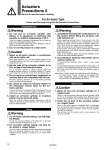
m-03-3c-seihin_en 17 / 77
10秒後にBOOKのページに移動します
Maintenance Caution 1. Bleed air from the air-hydro cylinder on a regular basis. Since air may accumulate inside an air-hydro cylinder, bleed air from it, for example before starting work. Bleed air from a bleeder valve provided on the air-hydro cylinder or the piping. 2. Verify the oil level of the air-hydro system on a regular basis. Since a very small amount of hydraulic fluid is discharged from the air-hydro cylinder and air-hydro unit circuit, the fluid will gradually decrease. Therefore, check the fluid regularly and refill as necessary. The oil level can be checked with a level gauge in the air-hydro converter. Piping Warning 1. For air-hydro cylinder piping, use self-aligning fittings. Do not use one-touch fittings in the piping for an air-hydro cylinder, because oil leakage may occur. 2. For air-hydro cylinder piping, use hard nylon tubing or copper piping. As in the case of hydraulic circuits, surge pressures greater than the operating pressure may occur in an air-hydro cylinder’s piping, making it necessary to use safer piping materials. Lubrication Warning 1. Completely discharge the compressed air in the system before filling the air-hydro unit with hydraulic oil. When supplying hydraulic fluid to the air-hydro unit, first confirm that safety measures are implemented to prevent dropping of objects and the release of clamped objects, etc. Then, shut off the air supply and the equipment’s electric power and exhaust the compressed air in the system. If the air-hydro unit’s supply port is opened with compressed air still remaining in the system, there is a danger of hydraulic fluid being blown out. Refer to the Material Safety Data Sheet (MSDS) of the hydraulic fluid when supplying the fluid. 2. Use petroleum hydraulic fluid which can be used as turbine oil. If non-flammable hydraulic fluid is used, it may cause problems. The operating temperature range suitable for ISO VG32 is 15 to 35°C. If the operating temperature range is beyond that for ISO VG32, select ISO VG46 (suitable for operating range of 25 to 45°C). Note) Refer to SMC website for details about each manufacturer’s brand name of class 1 turbine oil (no additive) ISO VG32. Additionally, please contact SMC for details about class 2 turbine oil (with additives) ISO VG32. Design/Selection Warning 1. Do not use an air-hydro cylinder near flames, or in equipment or machinery that exceeds an ambient temperatures of 60°C. There is a danger of causing a fire because the air-hydro cylinder uses a flammable hydraulic fluid. Refer to the Material Safety Data Sheet (MSDS) of the hydraulic fluid when supplying the fluid. 2. Do not use the product in a clean room. Caution 1. Select an air-hydro cylinder in combination with an air-hydro unit. Since good operation of an air-hydro cylinder depends on its combination with an air-hydro unit, carefully select an appropriate air-hydro unit. 2. Set the load of the air-hydro cylinder to be 50% or less of the theoretical force. For an air-hydro cylinder to obtain constant speed and stopping accuracy similar of a hydraulic cylinder, it is necessary to keep the load at 50% or less of the theoretical output. 3. Do not use in an environment, equipment, or machine that is not compatible with oil mist. Air-hydro cylinders generate an oil mist during operation which may affect the environment. 4. Be certain to install an exhaust cleaner on the directional control valve for the airhydro cylinder. A very small amount of hydraulic fluid is discharged from the exhaust port of the air-hydro cylinder’s directional control valve, which may contaminate the surrounding area. 5. Install an air-hydro cylinder in locations where it can be serviced easily. Since the air-hydro cylinder requires maintenance, such as refilling of hydraulic fluid and bleeding of air, ensure sufficient space for these activities. For Air-hydro Type Please read this page along with the Actuators Precautions. Actuators Precautions 5 Be sure to read this before handling. 12